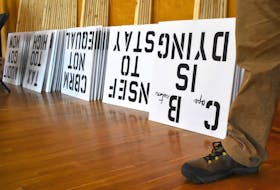Nazi act of terrorism or accidental fire? This is still the open question surrounding the most disastrous fire in 20th-century Newfoundland.
Dec. 12th, 2017 marked the 75th anniversary of the Knights of Columbus Hostel fire in St. John’s, which killed 99 people, including 22 members of the Royal Newfoundland Regiment.
The Knights of Columbus Hostel was opened in St. John’s in December 1941. The facility contained a reading room, restaurant, showers, dormitory, recreation room and a large auditorium.
On Saturday, Dec. 12th, 1942, approximately 350 servicemen and civilians filled the auditorium for a concert. Shortly after 11 p.m., the fire was discovered on the second floor.
At 11:07 p.m. officers patrolling outside reported the sky was lit up over the building. U.S. Army Cpl. Raymond Hoosier entered the dark building and calmly began assisting people who had been overcome by smoke inhalation. He was later decorated for bravery.
RNC Const. Clarence Bartlett also entered the inferno and rescued people. He was awarded the King’s Police and Fire Service Medal for his actions. His medal — the only one ever awarded to a Newfoundlander, is on display at the RNC Museum.
Fire engines were on the scene within minutes but could do little — the blaze was too intense. The next day, 99 charred bodies had been taken from the ruins. Eighty of the victims were members of various armed services from both the United States and Canada. Twelve women were among the dead and 10 victims could not be identified.
St. John’s was a small city, and the devastating fire understandably shocked people. Rumours flew that a Nazi agent had set the blaze, since in the preceding months several German U-boat attacks occurred elsewhere in Newfoundland.
Eleven days later, Justice Brian Dunfield was appointed to investigate the fire. When he delivered his report two months later, he said, “I am of the opinion, though I cannot prove it at present, that the fire was of incendiary origin.”
To date, the Knights of Columbus fire remains one of the top criminal mysteries in Newfoundland’s history.
Jim Stanton
Royal Newfoundland Regiment Museum Committee








